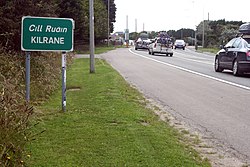Kilrane
| Kilrane Irish: Cill Ruáin | |
| County Wexford | |
|---|---|
 The N25 through Kilrane | |
| Location | |
| Grid reference: | T123113 |
| Location: | 52°14’31"N, 6°21’22"W |
| Data | |
| Population: | 647 (2016) |
| Local Government | |
Kilrane is a village in County Wexford. As of the 2016 census, the village had a population of 647 people.
The village is on the N25 road approximately eleven miles from Wexford and effectively merges with the adjacent settlement of Rosslare Harbour, the village centres being a mile apart. Significant volumes of traffic pass through the village in conjunction with ferry arrivals and departures.
Facilities in the village include two pubs, a takeaway, a craft shop and gallery, a barber, several B & Bs and a post box. A church and national school are also located in the village, and the Rosslare Harbour Maritime Heritage Centre is located at the edge of the village. There is a tradition of cricket in the area and Kilrane Cricket Club was active from 1974 to 1993.
Railway
Rosslare Europort railway station is approximately four minutes away by car or around twenty-five minutes on foot.
There was once a station at Kilrane itself, on Station Road. It closed to passengers in October 1970. The station house and offices were demolished the following year.[1] Kilrane ceased being a loading point for sugar beet in March 1977. 651 wagons of beet were loaded at Kilrane in the 1976–1977 season.[2] Beet was conveyed by rail to the Irish Sugar Company factory in Thurles.[3]
History
County Wexgord's peculiar dialect, Yola, was once spoken in the area. A plaque commemorating the Wexford Rebellion is located adjacent to the N25/Saint Helen's Road junction and features text in the language.
St Ruane's Church was built in the 1830s.[4][5]
References
- ↑ Evening Echo, 15 June 1971
- ↑ Evening Echo, 17 February 1977
- ↑ Sunday Independent 11 October 1970
- ↑ "History". https://rosslareharbourparish.ie/parish-history/.
- ↑ "Saint Ruane's Catholic Church, CHURCHTOWN (FO. BY.) ST. Helen's ED, Kilrane, WEXFORD". https://www.buildingsofireland.ie/buildings-search/building/15704823/saint-ruanes-catholic-church-originally-saint-rhanuss-catholic-church-churchtown-fo-by-st-helens-ed-kilrane-county-wexford.
- Cill Ruáin / Kilrane: Placenames Database of Ireland